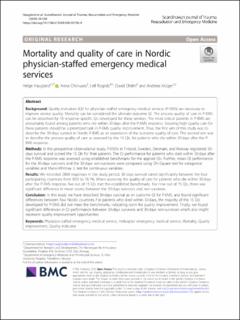| dc.contributor.author | Haugland, Helge Nystad | |
| dc.contributor.author | Olkinoura, Anna | |
| dc.contributor.author | Rognås, Leif Kåre | |
| dc.contributor.author | Ohlén, David | |
| dc.contributor.author | Krüger, Andreas | |
| dc.date.accessioned | 2022-11-21T08:47:57Z | |
| dc.date.available | 2022-11-21T08:47:57Z | |
| dc.date.created | 2020-10-20T12:15:46Z | |
| dc.date.issued | 2020 | |
| dc.identifier.citation | Scandinavian Journal of Trauma, Resuscitation and Emergency Medicine 2020,100 (28), 1-8 | en_US |
| dc.identifier.issn | 1757-7241 | |
| dc.identifier.uri | https://hdl.handle.net/11250/3033046 | |
| dc.description.abstract | Background: Quality indicators (QI) for physician staffed emergency medical services (P-EMS) are necessary to improve service quality. Mortality can be considered the ultimate outcome QI. The process quality of care in P-EMS can be described by 15 response-specific QIs developed for these services. The most critical patients in P-EMS are presumably found among patients who die within 30 days after the P-EMS response. Securing high quality care for these patients should be a prioritized task in P-EMS quality improvement. Thus, the first aim of this study was to describe the 30-days survival in Nordic P-EMS as an expression of the outcome quality of care. The second aim was to describe the process quality of care as assessed by the 15 QIs, for patients who die within 30 days after the P-EMS response.
Methods: In this prospective observational study, P-EMSs in Finland, Sweden, Denmark, and Norway registered 30-days survival and scored the 15 QIs for their patients. The QI performance for patients who died within 30 days after the P-EMS response was assessed using established benchmarks for the applied QIs. Further, mean QI performance for the 30-days survivors and the 30-days non-survivors were compared using Chi-Square test for categorical variables and Mann-Whitney U test for continuous variables.
Results: We recorded 2808 responses in the study period. 30-days survival varied significantly between the four participating countries; from 89.0 to 76.1%. When assessing the quality of care for patients who die within 30 days after the P-EMS response, five out of 15 QIs met the established benchmarks. For nine out of 15 QIs, there was significant difference in mean scores between the 30 days survivors and non-survivors.
Conclusion: In this study we have described 30-days survival as an outcome QI for P-EMS, and found significant differences between four Nordic countries. For patients who died within 30 days, the majority of the 15 Qis developed for P-EMS did not meet the benchmarks, indicating room for quality improvement. Finally, we found significant differences in QI performance between 30-days survivors and 30-days non-survivors which also might represent quality improvement opportunities. | en_US |
| dc.language.iso | eng | en_US |
| dc.publisher | BioMed Central Ltd. | en_US |
| dc.rights | Navngivelse 4.0 Internasjonal | * |
| dc.rights.uri | http://creativecommons.org/licenses/by/4.0/deed.no | * |
| dc.title | Mortality and quality of care in Nordic physician-staffed emergency medical services | en_US |
| dc.type | Peer reviewed | en_US |
| dc.type | Journal article | en_US |
| dc.description.version | publishedVersion | en_US |
| dc.source.journal | Scandinavian Journal of Trauma, Resuscitation and Emergency Medicine | en_US |
| dc.identifier.doi | 10.1186/s13049-020-00796-9 | |
| dc.identifier.cristin | 1840842 | |
| cristin.ispublished | true | |
| cristin.fulltext | original | |
| cristin.qualitycode | 1 | |

